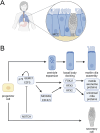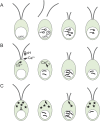Cilia and transcription: a mini review
- PMID: 40552307
- PMCID: PMC12183034
- DOI: 10.3389/fcell.2025.1582796
Cilia and transcription: a mini review
Abstract
Cilia assembly is accompanied by rapid and highly coordinated transcription of hundreds of genes. Cilia gene regulation has been studied extensively in both metazoans and unicellular model organisms. The forkhead and RFX family transcription factors regulating cilia genes in animals were first identified 25 years ago and considerable molecular details of the regulatory processes have been described since then. While many of the most important early studies of cilia gene regulation were done in unicellular organisms, additional molecular players need to be discovered for a more complete understanding in these organisms. In this concise review, written primarily for students new to the field, I present a brief history of research on cilia gene regulation, highlight some key metazoan discoveries from the last decade, and discuss gaps in our understanding of cilia gene regulation in unicellular model organisms with a focus on Chlamydomonas reinhardtii.
Keywords: Chlamydomonas; FoxJ1; RFX; XAP5; cilia; flagella; gene regulation; transcription.
Copyright © 2025 Brown.
Conflict of interest statement
The author declares that the research was conducted in the absence of any commercial or financial relationships that could be construed as a potential conflict of interest.
Figures


Similar articles
-
The clinical effectiveness and cost-effectiveness of enzyme replacement therapy for Gaucher's disease: a systematic review.Health Technol Assess. 2006 Jul;10(24):iii-iv, ix-136. doi: 10.3310/hta10240. Health Technol Assess. 2006. PMID: 16796930
-
Signs and symptoms to determine if a patient presenting in primary care or hospital outpatient settings has COVID-19.Cochrane Database Syst Rev. 2022 May 20;5(5):CD013665. doi: 10.1002/14651858.CD013665.pub3. Cochrane Database Syst Rev. 2022. PMID: 35593186 Free PMC article.
-
Measures implemented in the school setting to contain the COVID-19 pandemic.Cochrane Database Syst Rev. 2022 Jan 17;1(1):CD015029. doi: 10.1002/14651858.CD015029. Cochrane Database Syst Rev. 2022. Update in: Cochrane Database Syst Rev. 2024 May 2;5:CD015029. doi: 10.1002/14651858.CD015029.pub2. PMID: 35037252 Free PMC article. Updated.
-
Psychological and/or educational interventions for the prevention of depression in children and adolescents.Cochrane Database Syst Rev. 2004;(1):CD003380. doi: 10.1002/14651858.CD003380.pub2. Cochrane Database Syst Rev. 2004. Update in: Cochrane Database Syst Rev. 2011 Dec 07;(12):CD003380. doi: 10.1002/14651858.CD003380.pub3. PMID: 14974014 Updated.
-
Single-incision sling operations for urinary incontinence in women.Cochrane Database Syst Rev. 2017 Jul 26;7(7):CD008709. doi: 10.1002/14651858.CD008709.pub3. Cochrane Database Syst Rev. 2017. Update in: Cochrane Database Syst Rev. 2023 Oct 27;10:CD008709. doi: 10.1002/14651858.CD008709.pub4. PMID: 28746980 Free PMC article. Updated.
References
Publication types
LinkOut - more resources
Full Text Sources

